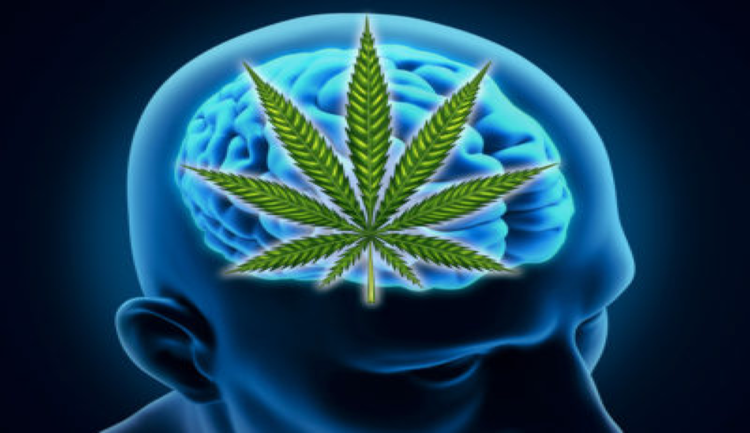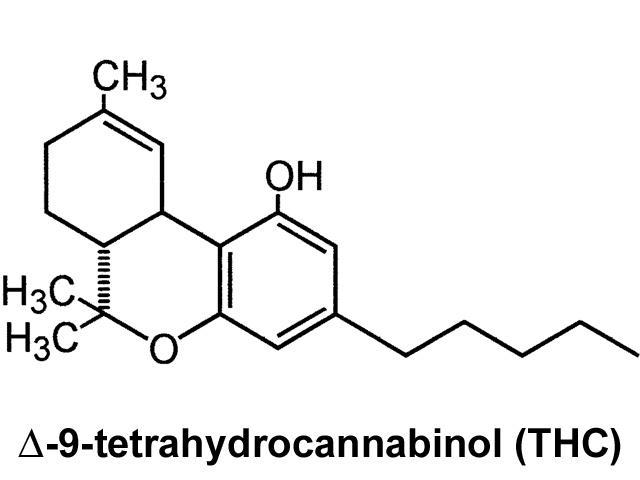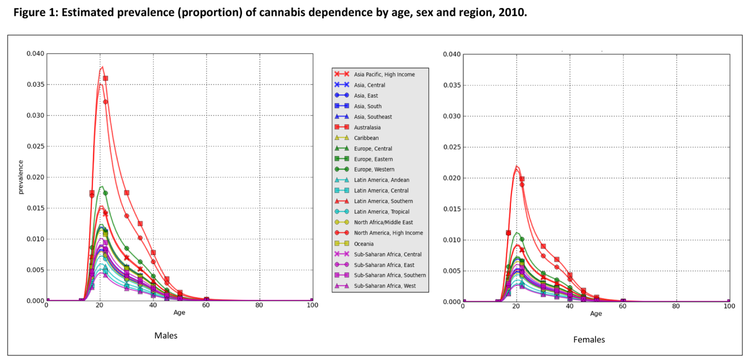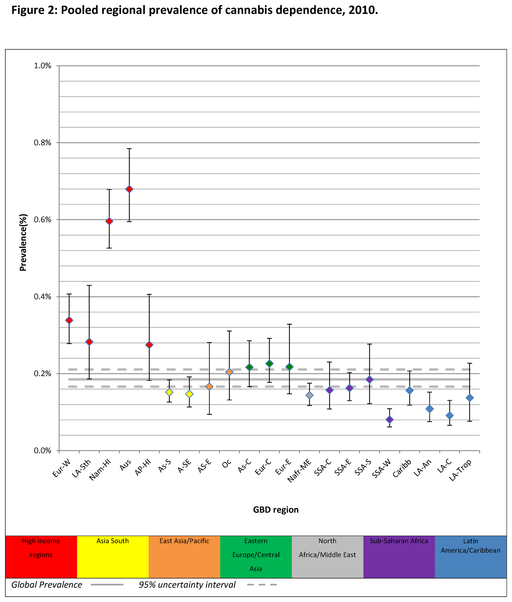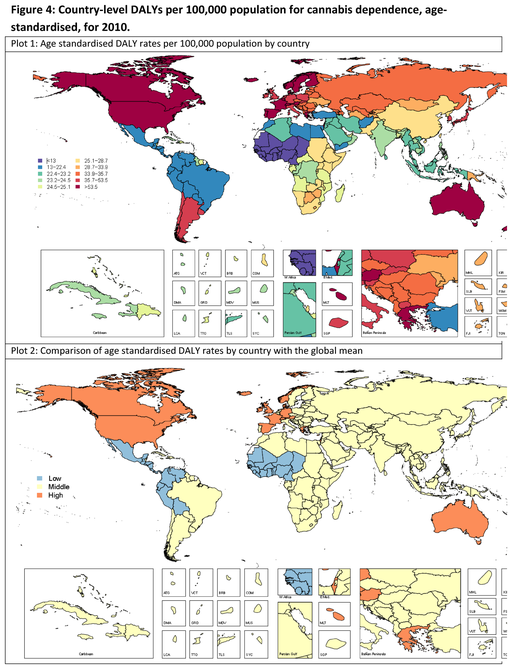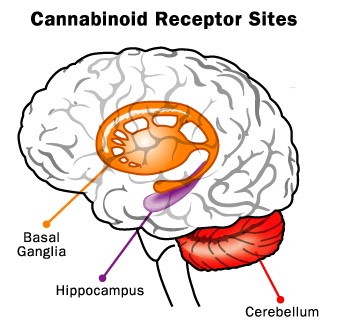This is an old revision of the document!
Table of Contents
INTRODUCTION
Marijuana comes from the hemp plant known as Cannabis Sativa (Deem, 2013). It is made up of a concoction of the dried, shredded leaves and flowers from this particular plant (Deem, 2013). Cannabis Sativa plants were initially native to Central and Southern Asia (Deem, 2013). However, today majority of its best-known varieties are grown in Colombia, Mexico, Brazil, and Africa (Deem, 2013). The dominant psychoactive chemical in marijuana, which is responsible for majority of the intoxicating, mind-altering effects that people experience, is delta-9-tetrahydrocannabinol (THC), seen in figure 1 (Deem, 2013). This chemical is found in its most abundant concentrations in resin, which is the byproduct of smoking marijuana. Resin can be smoked as well, however, it is considered to be the unhealthiest aspect of smoking marijuana due to its high concentrations of tar and carbon (Deem, 2013). Additionally, the plant contains over 500 other chemicals, including compounds chemically similar to THC, referred to as cannabinoids (Deem, 2013).
When marijuana is smoked, THC, along with the other chemicals contained within marijuana, pass from the lungs and enter the bloodstream. Once in the bloodstream these chemicals are rapidly carried throughout the body to the brain. The parts of the brain most affected by THC are the hippocampus and cerebellum, as these contain high levels of cannabinoid 1 receptors (which is what THC binds to) (Bonsor & Gerbis, 2001). Once these chemicals reach the brain the effects of the drug are felt. People’s experiences vary from a sense of relaxation, laughter, and increased appetite, to anxiety, fear, or panic. But the latter effects are most common when an individual is inexperienced with the drug or intakes a high amount (Bonsor & Gerbis, 2001). Detectable amounts of THC can remain in the body for days after use, however, noticeable effects from inhaled marijuana generally last between one to three hours (Bonsor & Gerbis, 2001). Once these effects ware off a person will generally return to their typical sober state. The reason why marijuana is considered dangerous is because the ingested THC binds to cannabinoid receptors found in the brain which leads to neural changes, affecting diverse cognitive processes. However, there is currently a lot of debate around how much of these changes are permanent (Bonsor & Gerbis, 2001).
—-
CANNABIS CONSUMPTION
CANNABIS USAGE
MEDICINAL
SPIRITUAL
RECREATIONAL
EPIDEMIOLOGY
In 2012, 43% of Canadians reported that they had used marijuana at some time in their lives, and 12% reported using it in the past year (Statistics Canada, 2013). Marijuana use was more common among males than females (Statistics Canada, 2013). People aged 18 to 24 had the highest prevalence of past-year marijuana use, and tended to use it more frequently than did people of other ages (Statistics Canada, 2013).
In Canada, as in many other countries, marijuana is the most commonly used illicit drug (Statistics Canada, 2013).
Throughout the world the prevalence was higher in males than females, resulting in an average male:female sex ratio of 1.8 (Degenhard et al, 2013). Prevalence peaks worldwide in the 20-24 years age group at between and then steadily decreasing after that age group thereafter (Degenhard et al, 2013).
Figure ##: Pooled regional prevalence of cannabis dependence, 2010. Note. Prevalence estimates were standardised by population age and sex; AP-HI: Asia Pacific, High Income, As-C: Asia Central, AS-E: Asia East, AS-S: Asia South, A-SE: Asia Southeast, Aus: Australasia, Caribb: Caribbean, Eur-C: Europe Central, Eur-E: Europe Eastern, Eur-W: Europe Western, LA-An: Latin America, Andean, LA-C: Latin America, Central, LA-Sth: Latin America, Southern, LA-Trop: Latin America, Tropical, Nafr-ME: North Africa/Middle East, Nam-HI: North America, High Income, Oc: Oceania, SSA-C: Sub-Saharan Africa, Central, SSA-E: Sub-Saharan Africa, East, SSA-S: Sub-Saharan Africa Southern, SSA-W: Sub-Saharan Africa, West. (Degenhard et al, 2013)
Prevalence in high income regions was much higher than that in low to middle income regions and the global average (Degenhard et al, 2013). Cannabis dependence in Australasia is about 8 times higher than prevalence in Sub-Saharan Africa, West (Degenhard et al, 2013).
Figure ##: Country-level DALYs per 100,000 population for cannabis dependence, age-standardised, for 2010. Note. Low: shows countries with statistically lower DALY rates than global mean; Middle: Shows countries with DALY rates that are not statistically different to global mean; High: Shows countries with statistically higher DALY rates than global mean. (Degenhard et al, 2013)
Worldwide, DALYs are closely associated with high income countries having more effected years compared to those of low income countries (Degenhard et al, 2013). The statistical DALY rates are comparably higher than the global mean in higher income countries than lower income (Degenhard et al, 2013).
SHORT-TERM EFFECTS
LONG-TERM EFFECTS
As a result of the chemical THC binding to cannabinoid 1 (CB1) receptors in the brain, observed long term morphological brain alterations connected to marijuana use are reported in CB1 receptor-enriched areas (Filbey et al, 2014). This includes regions such as the orbitofrontal cortex, amygdala, hippocampus, and cerebellum, a few of which are illustrated in figure # below (Filbey et al, 2014). Studies focusing on the physical brain effects from marijuana have found significant amounts of brain volume reductions in these CB1 enriched areas, particularly within the orbitofrontal cortex (Filbey et al, 2014). However, whether these reductions in brain volume lead to a cascade of downstream alterations in brain organization and function is still unknown. However, there is a high possibility that as a consequence of brain volume reductions, connectivity changes emerge as well (Filbey et al, 2014). These connectivity declines are currently a possible explanation for why someone who has used marijuana over long periods of time may appear cognitively slower.
A study done by Filbey et al used high-resolution MRI techniques to obtain brain images from a cohort of chronic cannabis users, in comparison to age- and sex-matched nonusing controls. Their obtained images revealed a significant decline in gray matter volume in the orbitofrontal cortex (OFC) in the marijuana users in comparison to the controls (Filbey et al, 2014). The OFC is the primary region in the reward network, and it is also enriched with CB1 receptors, which helps explain why it was mainly targeted in the chronic marijuana users. However, the cannabis group also showed higher levels of functional connectivity within the OFC compared with the control group, this can be seen in figure # below. These findings could help explain why marijuana users claim to experience feelings of creativity.
Additionally, the effects of cannabis may be beneficial to white matter by regulating mitochondrial activity and antioxidant processes, consequently protecting neurons on the molecular level (Filbey et al, 2014). These results suggest that OFC grey matter has higher vulnerability to the neurotoxic effects of cannabis use. In terms of cognition, marijuana use can cause functional impairment, however, the degree and/or duration of the impairment depends on the age when an individual initially began using and the duration of their use (Abuse, 2017). A large longitudinal study in New Zealand focused on the effects of marijuana as a result of age. Their findings revealed that persistent marijuana use beginning in adolescence was strongly associated with a loss of six to eight IQ points, as measured in mid-adulthood (Abuse, 2017). Significantly, those who partook in marijuana use heavily as teenagers but quit in adulthood, did not recover their lost IQ points (Abuse, 2017). Conversely, those who began using marijuana heavily in adulthood did not lose any IQ points (Abuse, 2017). These results suggest that marijuana has its strongest long-term impact on younger individuals, whose brains are still maturing and building new connections. Another study conducted by Zalesky et al expanded on the idea of cannabis use in adolescence and revealed that THC is hazardous to white matter of developing brains. However, he also suggests that the level of harm it elicits on white matter diminishes with age.
MECHANISM OF ACTION
Marijuana’s active ingredient, delta-9-tetrahydrocannabinol (THC) targets the endocannabinoid system, which is one the communication systems within the brain and body. This system is part of the CNS and is highly integrated with the full function of the body. There are 2 main parts of the endocannabinoid system, the cannabinoid (CB) receptors and the cannabinoids which act on these receptors (neurotransmitters). The human body produces natural cannabinoids called anandamide and 2-AG (arachidonoyl glycerol). THC is an agonist of these neurotransmitters and competes with the natural cannabinoids produced by the body (Scholastic, 2011).
Specifically there are 2 main CB receptors, CB1 receptors, which are abundant in the CNS and many parts of the brain, and the CB2 receptors whicher are found in tissues associated with immune function such as the spleen, leukocytes, and bone marrow. Particularly, CB1 receptors are the focus of the effects of marijuana on the brain (Scholastic, 2011).
Most nervous communication systems, neurotransmitter pathways start from vesicles inside the presynaptic cleft, exiting the presynaptic cleft and binding to receptors on the postsynaptic cleft. In contrast, specifically CB1 receptors are located on the presynaptic cleft, while anandamide and 2-AG are produced at the postsynaptic site, further released to bind to the CB1 receptors located on the pre-synaptic cleft. This reverse mechanism gives rise to its ultimate function, controlling all physiological changes induced by the neurotransmitters that create synapses from presynaptic to postsynaptic neurons (Iverson, L., 2003). Cannabinoids alter neurotransmitter trafficking and concentrations by controlling the mechanisms occurring in the presynaptic cleft, having to do with the release of many transmitters. In essence, cannabinoids are known as “dimmer switches” particularly due to how they modulate the prolonged or transient reduction of neurotransmitters. Specific physiological changes observed are the reduction of calcium uptake of pre-synaptic neurons, which are the main triggers of releasing neurotransmitter filled vesicles, as well as an increase of potassium which minimizes depolarization, dampening synapse activation (Iverson, L., 2003).
When marijuana is smoked, or administered into the body in other ways, THC, being an agonist of these natural cannabinoids, has a great concentration and is able to bind to these CB1 receptors in the brain (Scholastic, 2011). They override the natural system and takeover completely, having various effects such as slowing down reaction time, decrease function of short-term memory, affected judgment or cause of anxiety. In addition, THC triggers areas of the brain that make you feel good, known as the “high” (Scholastic, 2011).
The binding of THC initiates a signal transduction which essentially has 4 targets: adenylate cyclase, calcium channels, potassium channels, kinases and ceramides (Vathi, S., 2013). Adenyl cyclase modulation leads to an increase or decrease in cAMP, in this a decrease, further causing a decrease in calcium from intracellular stores located in the pre-synaptic cleft. For potassium channels, cannabinoids act on the Kir and Ka channels, which allows greater influx of potassium in the presynaptic cleft, causing hyperpolarization, in other words, a decrease in depolarization occurs (Vathi, S., 2013). We also see these CB1 receptors associated with enzymes that hydrolyze shingomyelin to ceramide and phosphocholine. These act as second messengers with activate pathways such as Raf1 and ERK. We also see proliferation and differentiation activated such as the JNK and p38 MAPK pathways (Vathi, S., 2013).
EFFECTS OF MARIJUANA ON THE BRAIN VIDEOS
EFFECTS OF MARIJUANA ON THE BRAIN POWERPOINT
References
Abuse, N.I. (2017). What are marijuana’s long-term effects on the brain? Retrieved April 01, 2017, from http://www.drugabuse.gov/publications/marijuana/what-are-marijuanas-long-term-effects-brain
Abush, H., & Akirav, I. (2012). Short-and long-term cognitive effects of chronic cannabinoids administration in late-adolescence rats. PLoS One, 7(2), e31731.
Ameri, Angela. “The Effects Of Cannabinoids On The Brain”. Progress in Neurobiology 58.4 (1999): 315-348. Web.
Block, R. I., O'leary, D. S., Ehrhardt, J. C., Augustinack, J. C., Ghoneim, M. M., Arndt, S., & Hall, J. A. (2000). Effects of frequent marijuana use on brain tissue volume and composition. Neuroreport, 11(3), 491-496.
Bolla, K. I., Brown, K., Eldreth, D., Tate, K., & Cadet, J. L. (2002). Dose-related neurocognitive effects of marijuana use. Neurology, 59(9), 1337-1343.
Bonsor, K., & Gerbis, N. (2001). How Marijuana Works. Retrieved April 02, 2017, from http://science.howstuffworks.com/marijuana3.htm
Borgelt, L. M., Franson, K. L., Nussbaum, A. M., & Wang, G. S. (2013). The pharmacologic and clinical effects of medical cannabis. Pharmacotherapy: The Journal of Human Pharmacology and Drug Therapy, 33(2), 195-209.
Brock, Tom. “CANNABINOID SIGNALING: THE ORIGINAL RETROGRADE SIGNALING PATHWAY”. Caymanchem.com. N.p., 2008. Web. 2 Apr. 2017.
Deem, R. (2013). The Medical “Benefits” of Smoking Marijuana (Cannabis): a Review of the Current Scientific Literatureby Rich Deem. Retrieved April 01, 2017, from http://www.godandscience.org/doctrine/medical_marijuana_review.html
Degenhardt, Louisa, Alize J. Ferrari, Bianca Calabria, Wayne D. Hall, Rosana E. Norman, John Mcgrath, Abraham D. Flaxman, Rebecca E. Engell, Greg D. Freedman, Harvey A. Whiteford, and Theo Vos. “The Global Epidemiology and Contribution of Cannabis Use and Dependence to the Global Burden of Disease: Results from the GBD 2010 Study.” PLoS ONE 8.10 (2013): n. pag. Web.
Filbey, F. M., Aslan, S., Calhoun, V. D., Spence, J. S., Damaraju, E., Caprihan, A., & Segall, J. (2014). Long-term effects of marijuana use on the brain. Proceedings of the National Academy of Sciences, 111(47), 16913-16918.
Hendershot, C. S., Magnan, R. E., & Bryan, A. D. (2010). Associations of marijuana use and sex-related marijuana expectancies with HIV/STD risk behavior in high-risk adolescents. Psychology of Addictive Behaviors, 24(3), 404.
H. (2015, September 17). The Effects Of Weed On Your Health. Retrieved April 01, 2017, from http://herb.co/2015/09/17/the-effects-of-weed-on-your-health/ Iversen, L. “Cannabis And The Brain”. Brain 126.6 (2003): 1252-1270. Web.
Osborne, G. B., & Fogel, C. (2008). Understanding the motivations for recreational marijuana use among adult Canadians. Substance use & misuse, 43(3-4), 539-572.
“The Science Of Marijuana: How THC Affects The Brain”. Headsup.scholastic.com. N.p., 2011. Web. 2 Apr. 2017.
“The Science Of The Endocannabinoid System: How THC Affects The Brain And The Body”. Headsup.scholastic.com. N.p., 2011. Web. 2 Apr. 2017.
“Prevalence and correlates of marijuana use in Canada, 2012.” Government of Canada, Statistics Canada. N.p., 27 Nov. 2015. Web. 02 Apr. 2017.
Vathi, Sonila. “Endocannabinoid System: Key Regulatory Enzymes And Physio-Pathological Implications”. Flipper.diff.org. N.p., 2014. Web. 2 Apr. 2017.
Short- & Long-Term Effects of Marijuana - Negative Side Effects of Weed - Drug-Free World. (n.d.). Retrieved April 01, 2017, from http://www.drugfreeworld.org/drugfacts/marijuana/short-and-long-term-effects.html
